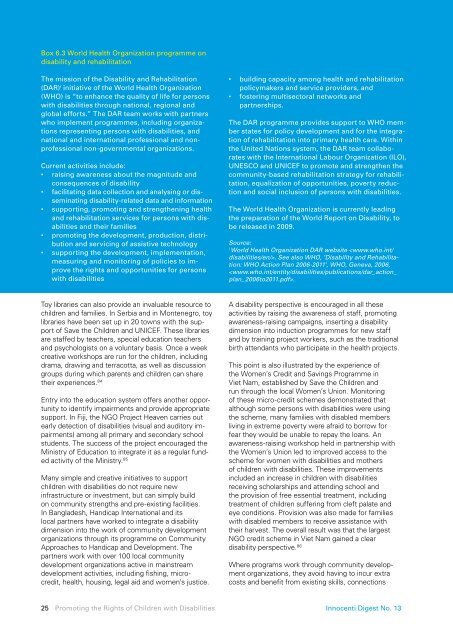Promoting the Rights of Children with Disabilities, UNICEF
Promoting the Rights of Children with Disabilities, UNICEF
Promoting the Rights of Children with Disabilities, UNICEF
- No tags were found...
Create successful ePaper yourself
Turn your PDF publications into a flip-book with our unique Google optimized e-Paper software.
Box 6.3 World Health Organization programme ondisability and rehabilitationThe mission <strong>of</strong> <strong>the</strong> Disability and Rehabilitation(DAR) i initiative <strong>of</strong> <strong>the</strong> World Health Organization(WHO) is “to enhance <strong>the</strong> quality <strong>of</strong> life for persons<strong>with</strong> disabilities through national, regional andglobal efforts.” The DAR team works <strong>with</strong> partnerswho implement programmes, including organizationsrepresenting persons <strong>with</strong> disabilities, andnational and international pr<strong>of</strong>essional and nonpr<strong>of</strong>essionalnon-governmental organizations.Current activities include:• raising awareness about <strong>the</strong> magnitude andconsequences <strong>of</strong> disability• facilitating data collection and analysing or disseminatingdisability-related data and information• supporting, promoting and streng<strong>the</strong>ning healthand rehabilitation services for persons <strong>with</strong> disabilitiesand <strong>the</strong>ir families• promoting <strong>the</strong> development, production, distributionand servicing <strong>of</strong> assistive technology• supporting <strong>the</strong> development, implementation,measuring and monitoring <strong>of</strong> policies to improve<strong>the</strong> rights and opportunities for persons<strong>with</strong> disabilities• building capacity among health and rehabilitationpolicymakers and service providers, and• fostering multisectoral networks andpartnerships.The DAR programme provides support to WHO memberstates for policy development and for <strong>the</strong> integration<strong>of</strong> rehabilitation into primary health care. Within<strong>the</strong> United Nations system, <strong>the</strong> DAR team collaborates<strong>with</strong> <strong>the</strong> International Labour Organization (ILO),UNESCO and <strong>UNICEF</strong> to promote and streng<strong>the</strong>n <strong>the</strong>community-based rehabilitation strategy for rehabilitation,equalization <strong>of</strong> opportunities, poverty reductionand social inclusion <strong>of</strong> persons <strong>with</strong> disabilities.The World Health Organization is currently leading<strong>the</strong> preparation <strong>of</strong> <strong>the</strong> World Report on Disability, tobe released in 2009.Source:iWorld Health Organization DAR website . See also WHO, ’Disability and Rehabilitation:WHO Action Plan 2006-2011’, WHO, Geneva, 2006,.Toy libraries can also provide an invaluable resource tochildren and families. In Serbia and in Montenegro, toylibraries have been set up in 20 towns <strong>with</strong> <strong>the</strong> support<strong>of</strong> Save <strong>the</strong> <strong>Children</strong> and <strong>UNICEF</strong>. These librariesare staffed by teachers, special education teachersand psychologists on a voluntary basis. Once a weekcreative workshops are run for <strong>the</strong> children, includingdrama, drawing and terracotta, as well as discussiongroups during which parents and children can share<strong>the</strong>ir experiences. 84Entry into <strong>the</strong> education system <strong>of</strong>fers ano<strong>the</strong>r opportunityto identify impairments and provide appropriatesupport. In Fiji, <strong>the</strong> NGO Project Heaven carries outearly detection <strong>of</strong> disabilities (visual and auditory impairments)among all primary and secondary schoolstudents. The success <strong>of</strong> <strong>the</strong> project encouraged <strong>the</strong>Ministry <strong>of</strong> Education to integrate it as a regular fundedactivity <strong>of</strong> <strong>the</strong> Ministry. 85Many simple and creative initiatives to supportchildren <strong>with</strong> disabilities do not require newinfrastructure or investment, but can simply buildon community strengths and pre-existing facilities.In Bangladesh, Handicap International and itslocal partners have worked to integrate a disabilitydimension into <strong>the</strong> work <strong>of</strong> community developmentorganizations through its programme on CommunityApproaches to Handicap and Development. Thepartners work <strong>with</strong> over 100 local communitydevelopment organizations active in mainstreamdevelopment activities, including fishing, microcredit,health, housing, legal aid and women’s justice.A disability perspective is encouraged in all <strong>the</strong>seactivities by raising <strong>the</strong> awareness <strong>of</strong> staff, promotingawareness-raising campaigns, inserting a disabilitydimension into induction programmes for new staffand by training project workers, such as <strong>the</strong> traditionalbirth attendants who participate in <strong>the</strong> health projects.This point is also illustrated by <strong>the</strong> experience <strong>of</strong><strong>the</strong> Women’s Credit and Savings Programme inViet Nam, established by Save <strong>the</strong> <strong>Children</strong> andrun through <strong>the</strong> local Women’s Union. Monitoring<strong>of</strong> <strong>the</strong>se micro-credit schemes demonstrated thatalthough some persons <strong>with</strong> disabilities were using<strong>the</strong> scheme, many families <strong>with</strong> disabled membersliving in extreme poverty were afraid to borrow forfear <strong>the</strong>y would be unable to repay <strong>the</strong> loans. Anawareness-raising workshop held in partnership <strong>with</strong><strong>the</strong> Women’s Union led to improved access to <strong>the</strong>scheme for women <strong>with</strong> disabilities and mo<strong>the</strong>rs<strong>of</strong> children <strong>with</strong> disabilities. These improvementsincluded an increase in children <strong>with</strong> disabilitiesreceiving scholarships and attending school and<strong>the</strong> provision <strong>of</strong> free essential treatment, includingtreatment <strong>of</strong> children suffering from cleft palate andeye conditions. Provision was also made for families<strong>with</strong> disabled members to receive assistance <strong>with</strong><strong>the</strong>ir harvest. The overall result was that <strong>the</strong> largestNGO credit scheme in Viet Nam gained a cleardisability perspective. 86Where programs work through community developmentorganizations, <strong>the</strong>y avoid having to incur extracosts and benefit from existing skills, connections25 <strong>Promoting</strong> <strong>the</strong> <strong>Rights</strong> <strong>of</strong> <strong>Children</strong> <strong>with</strong> <strong>Disabilities</strong> Innocenti Digest No. 13
















